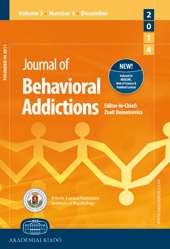Observable Indicators and Behaviors for the Identification of Problem Gamblers in Venue Environments
Observable Indicators and Behaviors for the Identification of Problem Gamblers in Venue Environments
Author(s): Paul H. Delfabbro, Anna Thomas, Andrew ArmstrongSubject(s): Public Law, Social psychology and group interaction, Behaviorism, Substance abuse and addiction
Published by: Akadémiai Kiadó
Keywords: problem gambling; identification; customer behavior; staff training; harm minimization;
Summary/Abstract: In many jurisdictions, where gambling services are provided, regulatory codes require gambling operators to apply a duty of care toward patrons. A common feature of these provisions is some expectation that venue staff identify and assist patrons who might be experiencing problems with their gambling. The effectiveness of such measures is, however, predicated on the assumption that there are reliable and observable indicators that might be used to allow problem gamblers to be distinguished from other gamblers. Methods: In this study, we consolidate the findings from two large Australian studies (n = 505 and n = 680) of regular gamblers that were designed to identify reliable and useful indicators for identifying problem gambling in venues. Results: It was found that problem gamblers are much more likely to report potentially visible emotional reactions, unusual social behaviors, and very intense or frenetic gambling behavior. Discussion and conclusions: This study shows that there are a range of indicators that could potentially be used to identify people experiencing problems in venues, but that decisions are most likely to be accurate if based on an accumulation of a diverse range of indicators.
Journal: Journal of Behavioral Addictions
- Issue Year: 5/2016
- Issue No: 3
- Page Range: 419-428
- Page Count: 10
- Language: English

